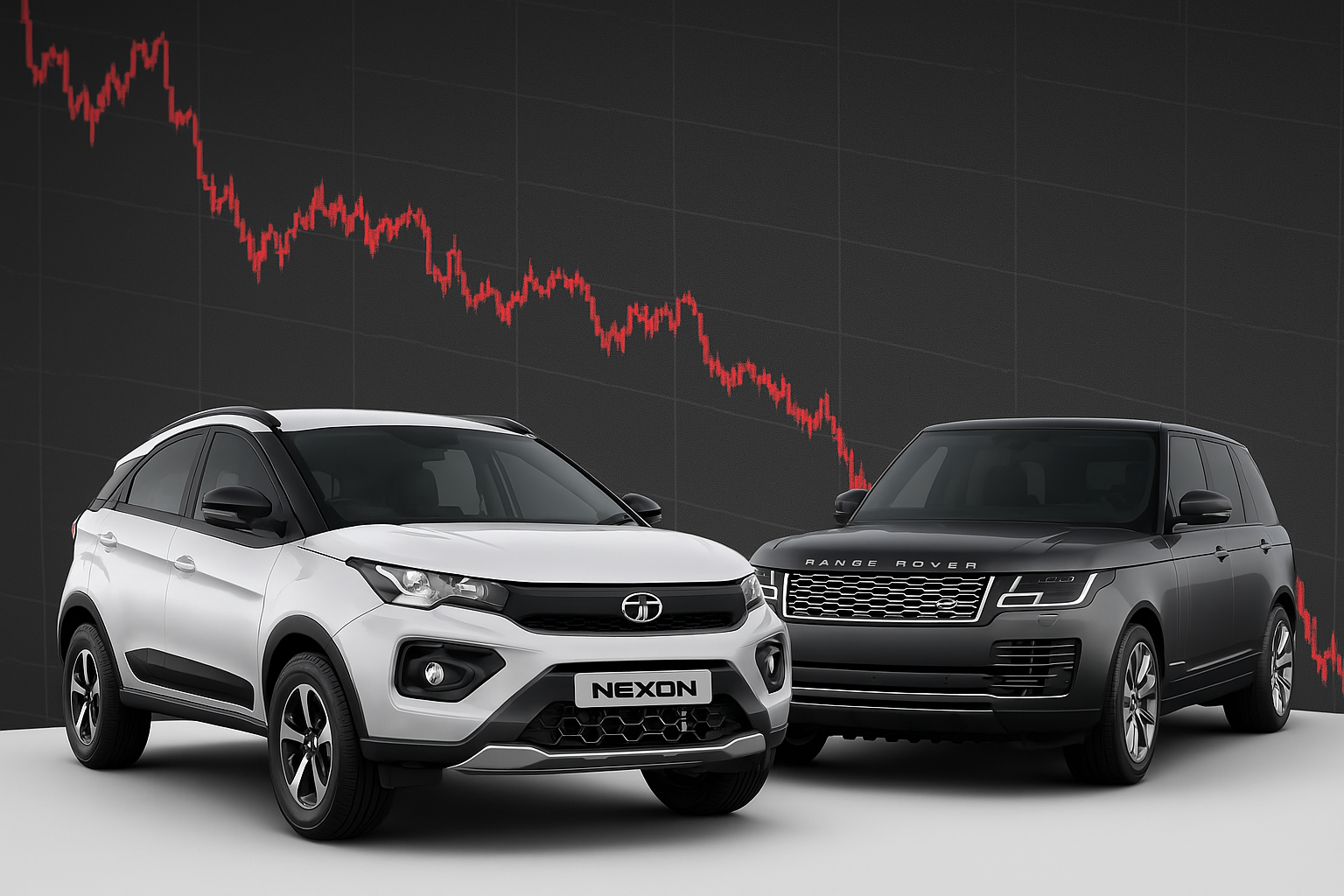
Tata Motors has reported a mixed performance in its Consolidated Q1 FY26 results, with revenues and profitability under pressure due to declining volumes across all major business segments and a sharp drop in profitability at Jaguar Land Rover (JLR). The company’s consolidated revenue stood at ₹104,400 crore, down 2.5% year-on-year, while EBIT fell to ₹4,500 crore, a decline of ₹4,100 crore, translating into an EBIT margin of 4.3%—down 370 basis points. Consolidated PBT (before exceptional items) was ₹5,600 crore, benefiting from a significant reduction in finance costs. Auto free cash flow for the quarter was negative at ₹12,300 crore.
The performance in Q1 was adversely impacted by a volume decline across all divisions, with JLR’s numbers being hit the hardest by US trade tariffs. JLR revenue fell 9.2% to £6.6 billion, while EBITDA margins slipped 650 basis points to 9.3%, and EBIT margins declined 490 basis points to 4.0%. Profit before tax dropped sharply to £351 million, down 49.4% year-on-year, due to the tariff impact and foreign exchange headwinds.
Despite these headwinds, JLR managed to deliver its 11th consecutive profitable quarter. The quarter also saw the signing of a UK-US trade deal reducing tariffs on UK-produced vehicles exported to the US from 27.5% to 10%, effective June 30, 2025. An EU-US trade deal announced on July 27, 2025, will further reduce tariffs on EU-produced vehicles exported to the US from 27.5% to 15% in due course. Free cash flow for JLR was negative £758 million, with liquidity standing at £5 billion, including an undrawn £1.7 billion revolving credit facility.
JLR continued its “Reimagine” transformation strategy during the quarter, with notable launches such as the Range Rover Electric prototype, which received critical acclaim and surpassed 65,000 on the waiting list. Other launches included Range Rover SV Masāra, SV Saturio, Defender OCTA Black Edition, and multiple special editions of the Discovery series. In the electrification push, JLR made over £100 million from reuse and refurbishment initiatives and progressed towards completing its EDU and battery manufacturing lines in Wolverhampton for next-generation electric vehicles.
In the commercial vehicles (CV) segment, Tata Motors reported Q1 FY26 revenue of ₹17,000 crore, down 4.7% year-on-year. EBITDA margin improved to 12.2% (up 60 bps), and EBIT margin rose to 9.7% (up 80 bps), resulting in PBT (before exceptional items) of ₹1,700 crore. Wholesales stood at 88,000 units, down 6% year-on-year, with domestic volumes falling 9% but exports surging 68%. Market share in domestic CV VAHAN registrations stood at 36.1%, with a strong presence in HGV+HMV (47.7%) and Passenger segments (36.9%). New launches included the Ace Pro, touted as India’s most affordable four-wheel mini-truck, and upgrades such as air-conditioned cabins across the truck range. The business also expanded its presence in Qatar with the launch of the LPO 1622 bus.
In the passenger vehicle (PV) segment, revenues fell 8.2% year-on-year to ₹10,900 crore. Wholesales were down 10.1% to 124,800 units, with electric vehicle wholesales slightly lower at 16,200 units, maintaining 13% EV penetration. EBITDA margin declined by 180 bps to 4.0%, and EBIT margin fell 310 bps to -2.8%, leading to a PBT loss of ₹129 crore.
The decline was driven by softer industry demand and the transition to new models such as Altroz, Harrier, and Safari. Nonetheless, Tata Motors achieved notable product milestones, including the launch of the Altroz premium hatchback, Harrier.ev SUV, and a lifetime high-voltage battery warranty for select EV models. The Tata Punch became the fastest SUV in India to cross the 6 lakh sales mark in under four years.
Corporate developments during the quarter included the conclusion of the final hearing for the company’s demerger scheme at the NCLT, with the effective date targeted for October 1, 2025. Additionally, on July 30, 2025, Tata Motors announced the €3.8 billion acquisition of Iveco Group N.V. (excluding Defence) through a voluntary tender offer, expected to close in the first half of 2026.
Looking ahead, Tata Motors expects demand challenges to persist but aims to strengthen business fundamentals and mitigate tariff impacts through an improved product mix and margin-focused actions. PB Balaji, Group CFO, said the company is targeting a strong second-half performance, supported by festive demand and tariff clarity, alongside the upcoming demerger.
JLR CEO Adrian Mardell expressed confidence in the long-term strategy, highlighting ongoing investments of £3.8 billion this fiscal year in next-generation EVs, including electric Range Rover and Jaguar models. In the CV business, Executive Director Girish Wagh said the focus will remain on double-digit EBITDA margins, high ROCE, and expanding market share through customer-centric innovation. In the PV business, Managing Director Shailesh Chandra noted that while industry growth is expected to remain muted, Tata Motors is optimistic about outperforming the market through new launches and a strong EV portfolio




